Spider mites on plants are a headache for outdoor gardens, houseplants and greenhouse plants. Once they get a foothold these tiny tiny bugs are tricky to fight.
In this post we learn effective methods of how to get rid of spider mites on indoor plants and out in the garden or greenhouse.
If you already know all about spider mites and are looking for the homemade insecticidal spray recipe click the jump to how to button at post top to avoid lengthy scrolling. 🙂
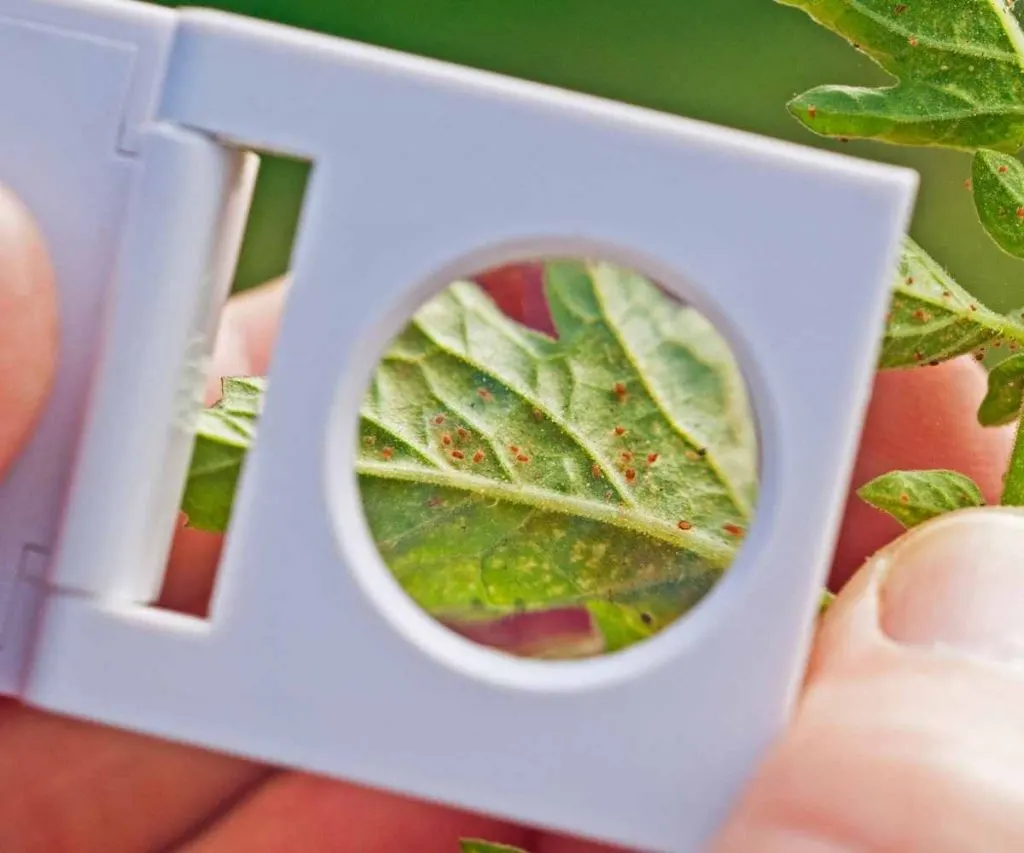
What do Spider Mites Look Like on Plants?
It’s useful to identify that you have spider mite damage in the early stages.
If you have a hand magnifier you can see the mites. Look on the underside of the leaves first.
Identifying the types of spider mites responsible for your plant damage is difficult and not really necessary for home gardeners and houseplant owners. They may be red mites like this…
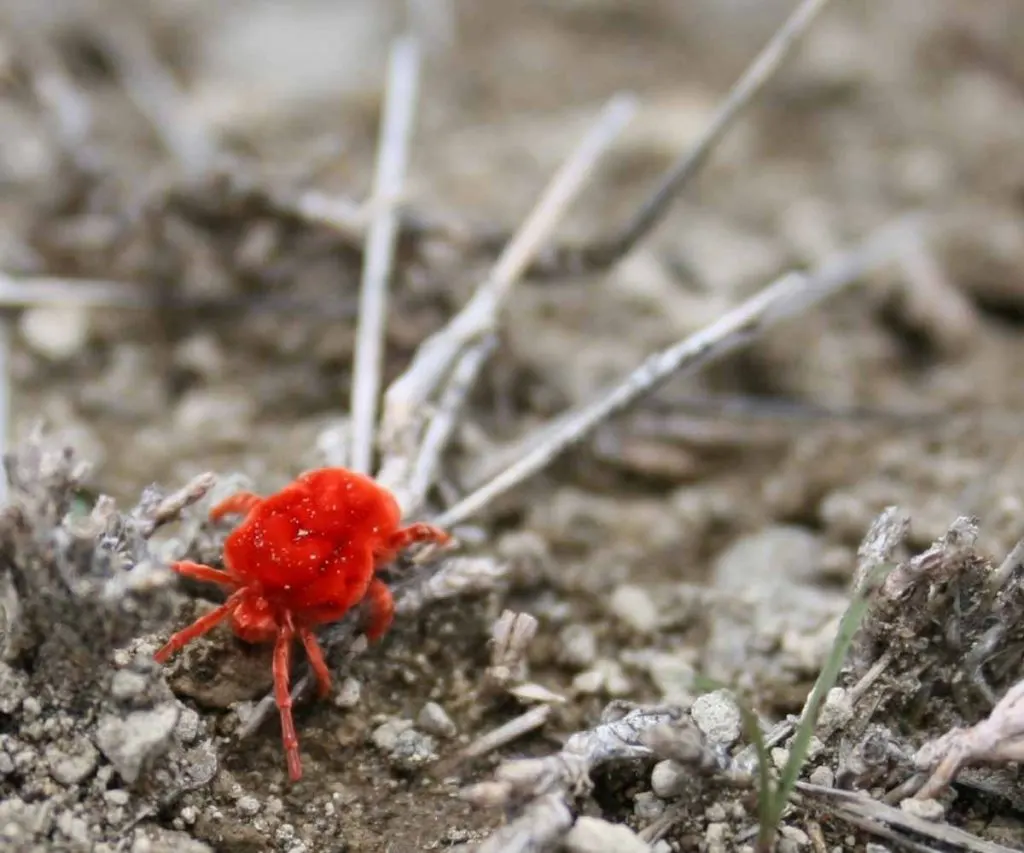
But Spider mites can also be yellow with spots and have different body types. It’s easy to confuse them with other sucking insects like aphids at first.
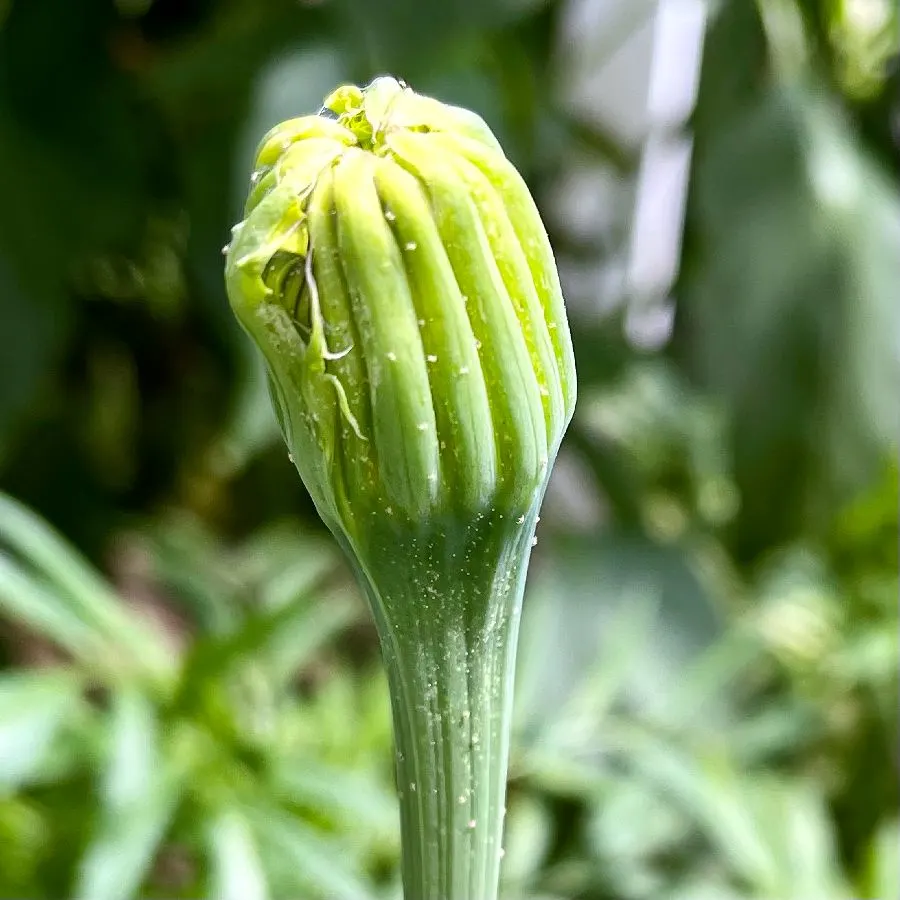
If you look closely at the picture above you can see the spider mite legs. Spider mites have eight creepy crawly legs. The picture gallery below shows the webbing with mites in them and the leaf damage spider mites cause.
These infestation pictures are of advanced spider mite infections. At this point the plant may be beyond saving if it is completely overtaken.
If only a leaf or two is involved cut the leaf off and seal it in a trash can well away from other plants.
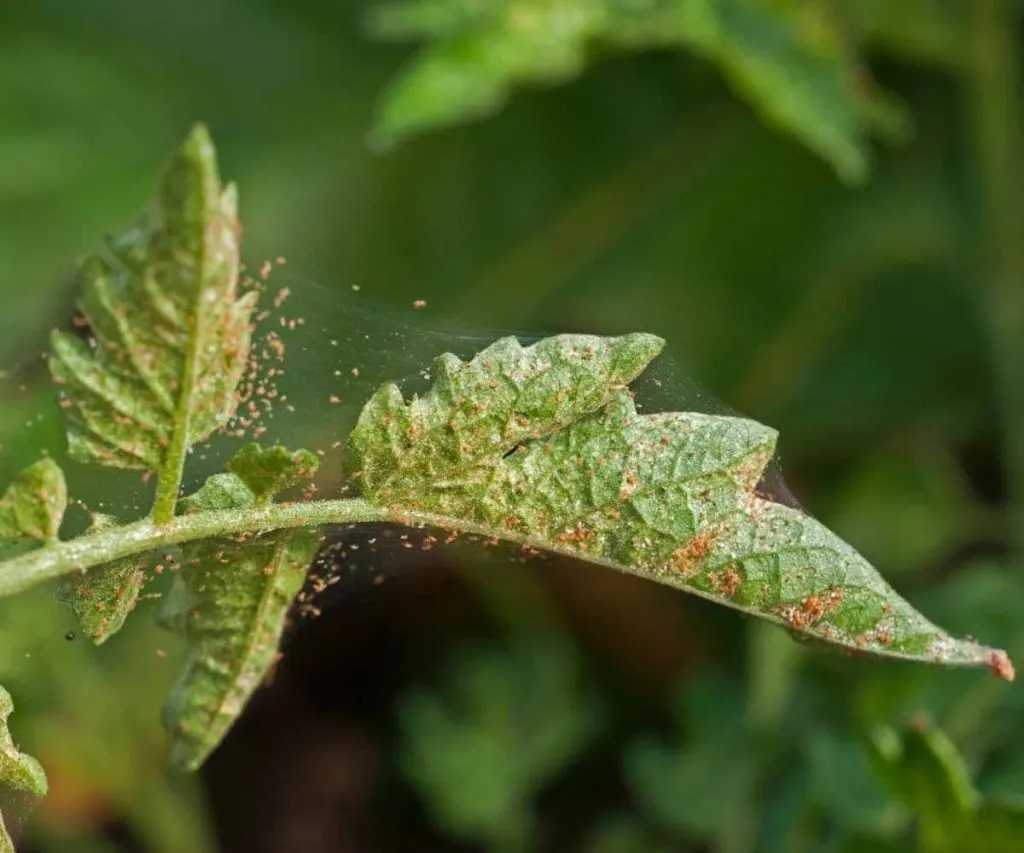
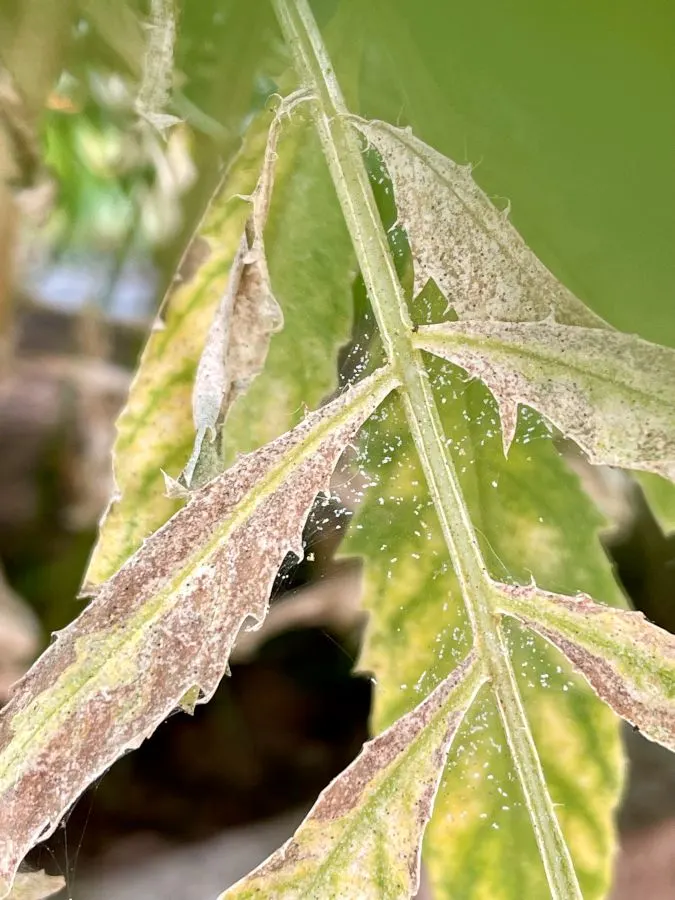
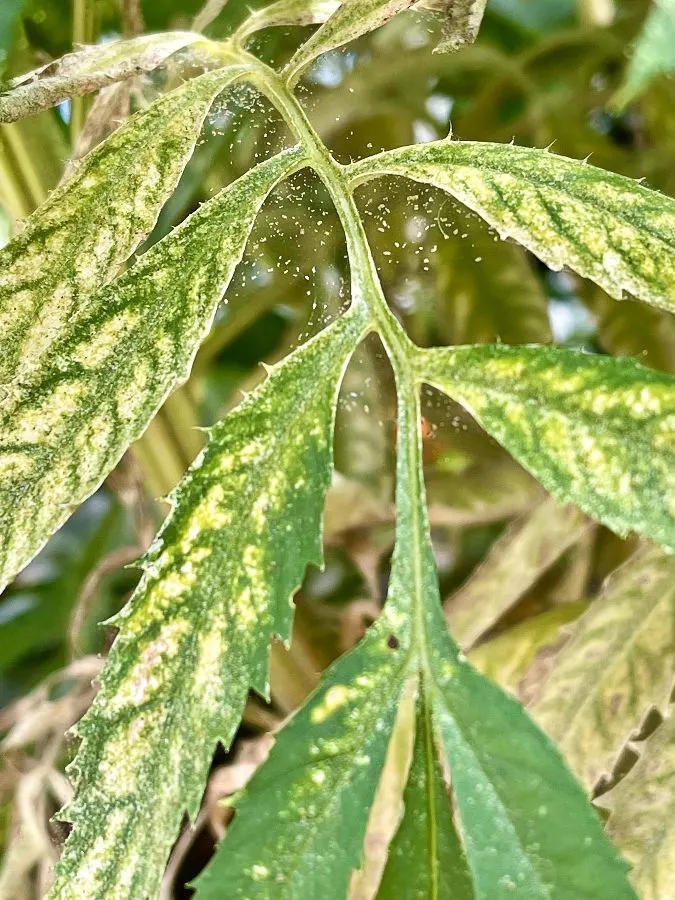
That’s how it went with our greenhouse marigolds. We overlooked the mites until the plants were overcome. These plants went into a sealed trash bag and immediately out to the dumpster.
When you look be sure to check the undersides of the plant leaves. The mites will be hiding under the leaf and not easy to spot.
Use a hand magnifier to get a closer look at the bugs on your plants. If you see webbing you are dealing with spider mites.
Spider Mites on Indoor plants are the same as those that infect outdoor ornamentals and garden crops.
Early signs of spider mites:
The damage may be easy to miss in the early stages of infestation.
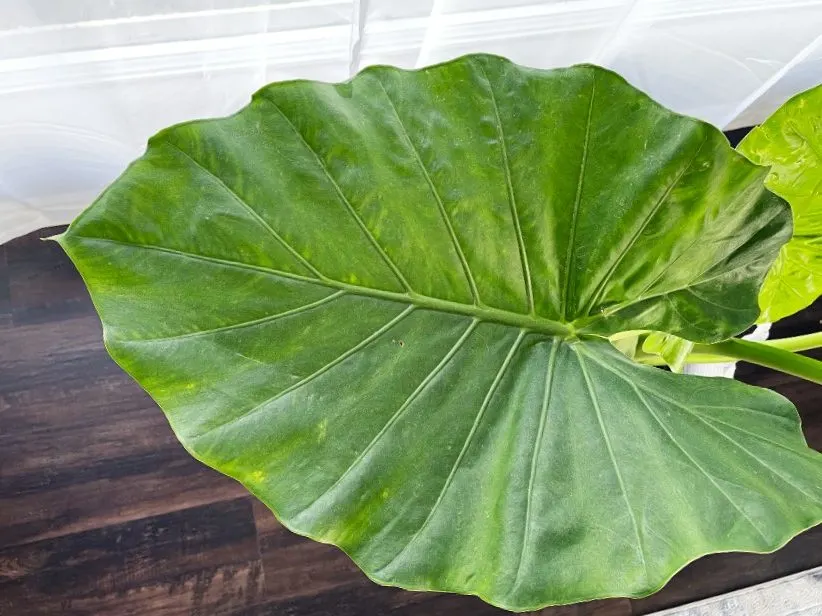
The Elephant ear pictured has a case of spider mites. But the damage is not all that noticeable on the leaf top. You have to look under the leaf to find them.
I bought this plant with a mite infection in full swing. I was so excited about getting an elephant ear at a good price I didn’t look closely at the plant. Lesson learned!
In this early stage of infestation there was no webbing. But the plant leaves have the telltale spots where the bugs have sucked the leaf juices out of the plant cells. And the bugs are on there. Just VERY small.
Spider Mite Damage:
Spider mites are sucking insects like Thrips, Aphids and Mealybugs. They attach themselves to plant cells and suck out the juices. The leaf cell dies eventually and the leaf is riddled with yellow spots. You can see this in my elephant ear plant.
I thought the leaves were beat up from the store traffic. Which they were. but I missed the light yellow places on the leaf that indicates a sucking insect damage.
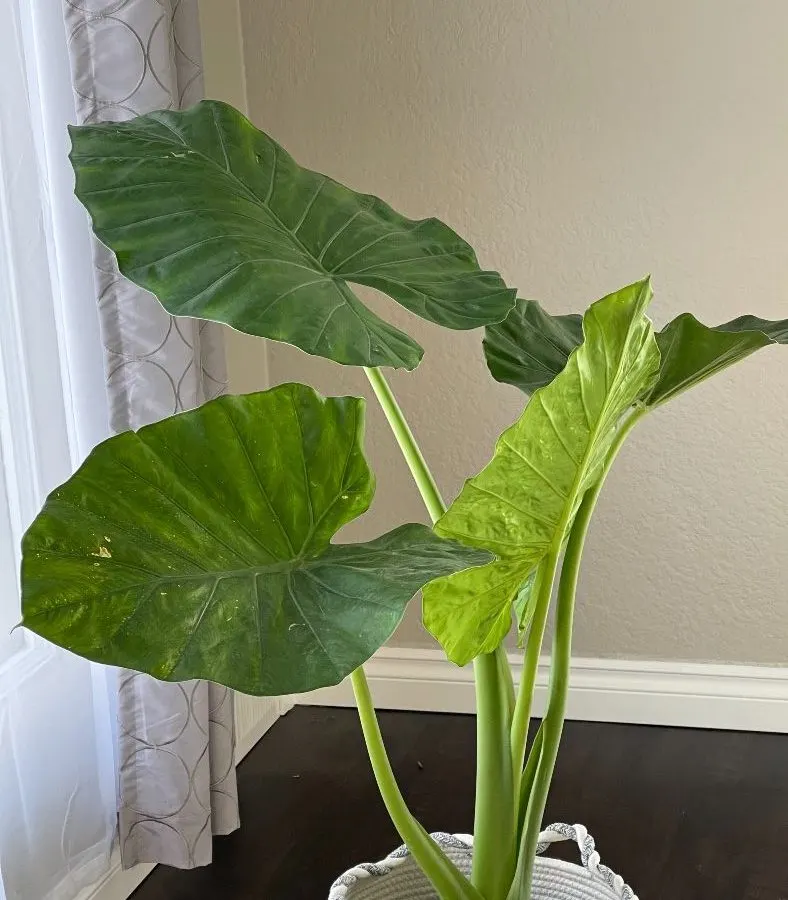
The marigold leaf below shows advance spider mite damage.
- Notice the light yellow sunburned look to the leaf. The leaf is dying from too many destroyed cells.
- The leaves in the back of the photo are curling up from dehydration. The leaf cannot absorb nutrients any longer.
- Finally the telltale webbing is full of mites. They have almost finished with this leaf and will move along to another leaf and soon the whole plant will be consumed.

Preventing Spider Mite Spread:
Spider mites go everywhere and travel in many ways. you can bring them home from the store on plants, they can hitch a ride on your cloths when you go from plant to plant indoors or out. And they can travel on their own tiny silken web threads. All they need is a tiny breeze and they can get quite far. So eventually, they will find you.
- Examine plants and plant starts CAREFULLY before purchase. Look for the early signs of leaf damage associated with spider mites, any suspicious webbing on the plant leaves, or the tiny mites themselves.
- Quarantine ALL new plant purchases away from your other plants. This way if you missed the signs in the store you will not spread it to your other plants.
- Do weekly checks on your plants for pest damage and visible signs of bugs.
- DO periodic Leaf washing to remove pests you cannot see. This prevents them from getting a foothold on your plants. You can use neem oil leaf shine, our insecticidal soap below, or 70% rubbing alcohol to wash your plant leaves and kill pests on contact.
- Spider mites particularly love low humidity environments. Discourage them with frequent misting of your plant leaves, humidity trays and leaf washings.
Spider Mite damage Indicators are the same among the spider mite types. Fortunately so are the strategies to get rid of them.
Purchase Homemade Insecticide Spray on Etsy
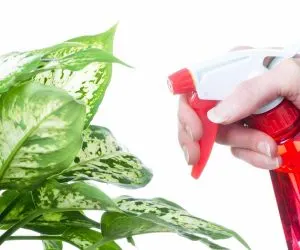
NOTE: Not all webs on your plants are from spider mites. Real spiders do sometimes put webs on plants and are beneficial in the garden and greenhouse. But they will not do damage to your plants. Be sure you know you are getting rid of spider mites, not real spiders.
The Contented Plant
How To Safely Dispose Of Infested HousePlants:
If you see a LOT of pest damage and want to get rid of the plant rather than treat it, here’s the proper way to do it.
- Take the whole plant and set it in an airtight garbage bag.
- Seal the bag.
- Throw it into the garbage OUTSIDE.
- Do NOT throw a plant live with pests into your compost pile or anywhere they can continue their life cycle.
- Be sure to sterilize the home surfaces you and the plant came in contact with.
- Any other houseplants grouped together with the affected one should also be checked for pests and sprayed with a neem oil insecticidal spray.
NEVER compost plants with ANY pest infection. You will just grow a pest problem into your compost.
The Contented Plant
How To Get Rid Of Spider Mites on Plants:
- Like aphids, these bugs live on your plants leaves and buds. LOOK at your plant leaves. WATCH for early signs of pest damage as discussed above.
- You can spray spider mites off plants in your garden or greenhouse like aphids with a strong stream of water or insecticidal soap. You will have to rinse off the soap if it burns the plant leaves.
- Cut off leaves with webs and large infestations of mites. Close the infested leaves into a sealed bag and throw it in the garbage. NOT the compost pile.
- Wash your hands and change your cloths when dealing with heavily infested plants. Spider mites will travel on your cloths and drop off on other plants.
- Pull up plants completely overcome with mites. The plant will be completely webbed with visible mites and yellow sick leaves. Get it AWAY from other plants that still have a good chance of saving with mite control methods.
- For houseplants wipe your plant leaves off with water or neem oil leaf shine. This mechanically removes all pests as you clean off the leaves. We recommend a weekly leaf check and at least a monthly wash off your houseplant leaves.
- Our homemade insecticidal soap recipe below works well to kill spider mites and other plant pests. This insecticidal soap will kill spider mites and other common houseplant plant pests like thrips, whiteflies and mealybugs.
It also works well at a larger volume in greenhouses and outdoor gardens. Adjust the volume to your needs. We have used this spray for years with great success in hand sprayers and larger outdoor sprayers.
Homemade Insecticidal Soap Recipe
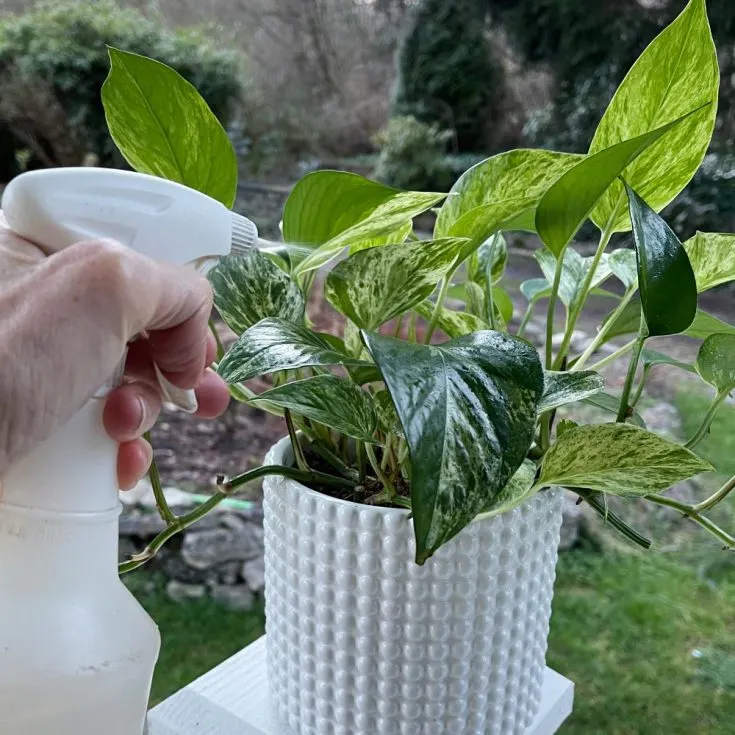
Materials
- 1 Tablespoon pure castile liquid dish soap (or other organic dish soap)
- Neem Oil
- 1 quart water-soft or average hard water for best results.
- OPTIONAL:
- A few added drops of lavender, peppermint, or orange oil
Instructions
- mix the water, neem oil and soap into a solution.
- Pour solution into the spray bottle.
- spray on the affected plant leaves on the top and bottom.
- Also spray stems, intersections and buds of flowers.
- Leave the solution on the plants overnight.
- Spray the plants with water after 12 hours or so to rinse the leaves and remove dead spider mites.
- Reapply as needed. To interrupt the spider mite life cycle spray every three days for two weeks.
Although the basic recipe will work as described you may wish to enhance your formula by adding
1/4 Teaspoon of organic vinegar to combat mildew. (avoid vinegar for sentive plants)
A few added drops of lavender, peppermint, or orange oil in this recipe will help repel pests and smells great!
Notes
Sensitivity of Plants:
If you find this recipe is too harsh and burns your plants. Cut the soap amount in half or follow this spray with an immediate spray of plain water to protect your plant leaves. Also sensitive plants like ferns, succulents, azaleas and waxy leaved plants may be harmed by this spray.
Water Hardness matters:
This recipe is most effective with average to soft water. A hard water will yield a less effective insecticidal spray recipe and can leave soap scum on your plant leaves.
How to use this Spray:
- DIY Organic Insecticidal Soap Recipe works on contact which means it must coat the insect to kill it.
- This spray has No residual effect and must be applied several times at weekly intervals for best control.
- Spray the entire plant with special focus on those areas of your plant where you can find the bugs.
- Spray in the morning or evening in cooler temperatures and when plants are shaded. You want the spray to last. Once it dries the spray is ineffective.
Go to our Homemade Food Junkie article For more on this recipe
The cost of this recipe is determined by which soap you use and if you have to purchase a spray bottle.
This insecticidal soap is not effective on fungus gnats. Read this article on how to kill and manage Fungus Gnats
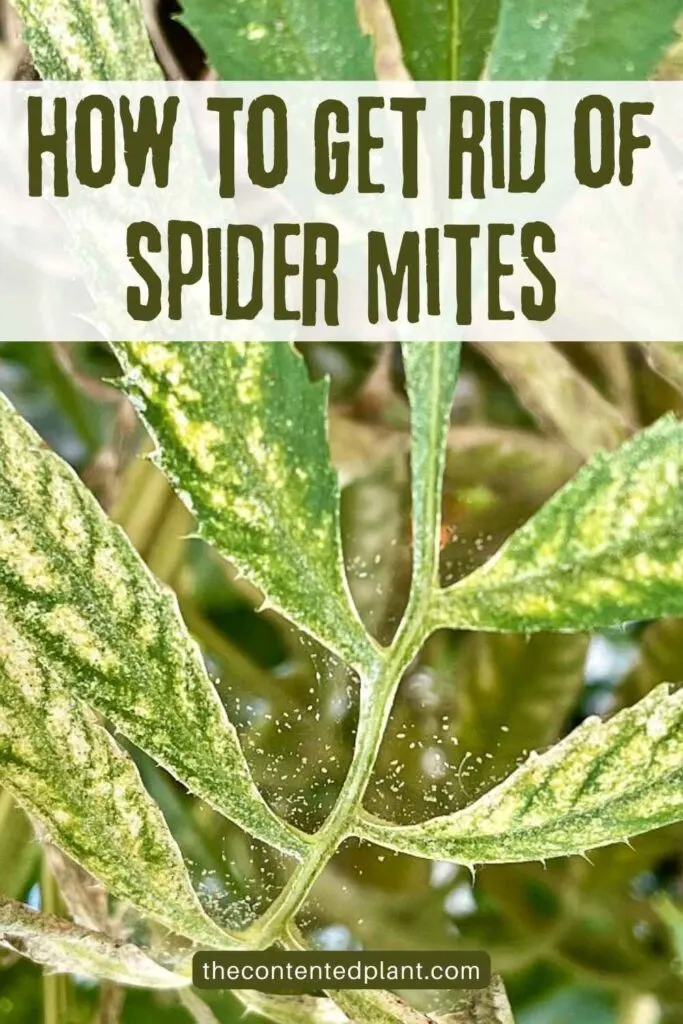
More Plant Posts From The Contented Plant:
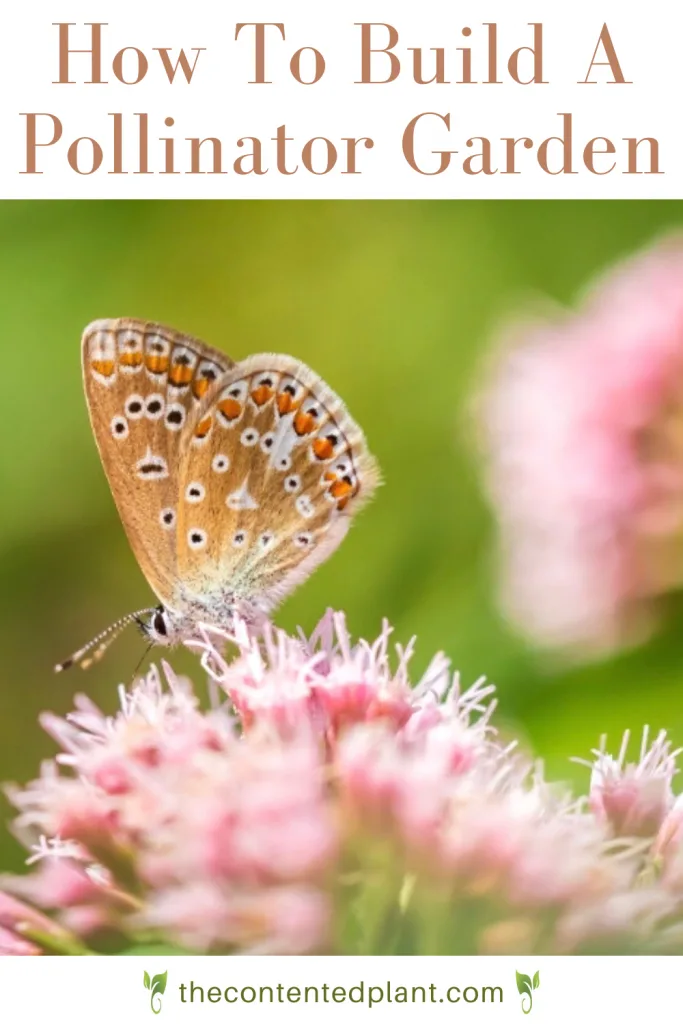
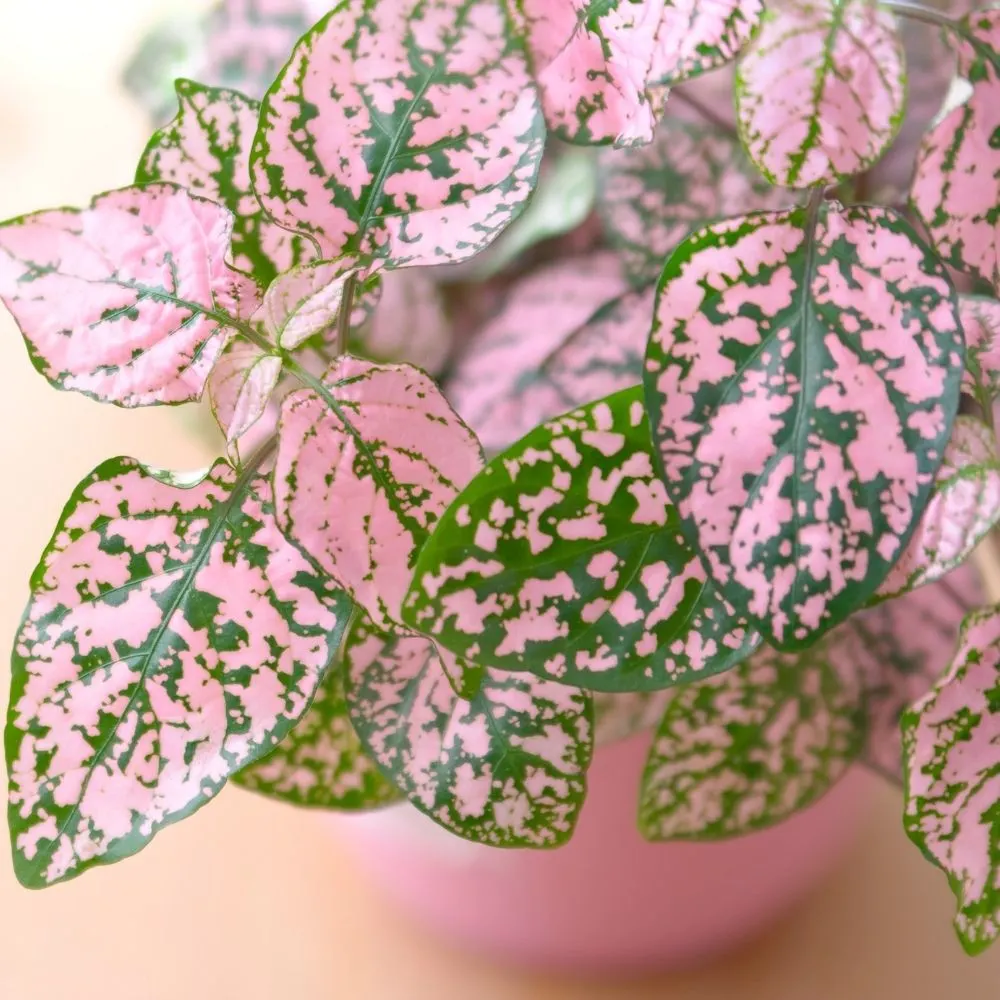
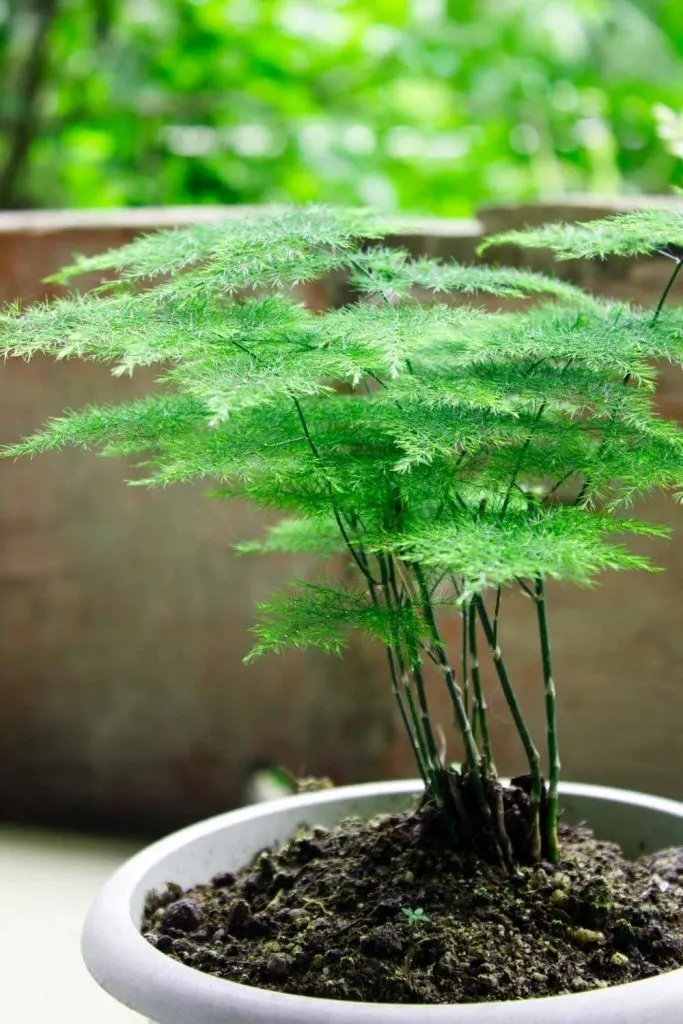
Follow Us:
Find us on YouTube, Instagram , Pinterest and TikTok! We love to Plant chat. We also comment, like and occasionally share your content to our daily stories. We’d love to see your plants. Share your joy in your houseplants. Happy Planting!

Rebutia Cactus - The Contented Plant
Thursday 13th of July 2023
[…] for common cactus pests like mealybugs, scale insects, and spider mites. Ensure good airflow and avoid overwatering to prevent fungal […]
7 Common Indoor Plant Pests (& How to Kill them) -
Tuesday 27th of September 2022
[…] How to Get Rid of Spider Mites on Plants […]
How to Use Hydrogen Peroxide For plants - The Contented Plant
Tuesday 9th of August 2022
[…] help kill pests on the plant leaves like Aphids, spider mites and other sapsuckers use the misting solution […]
Snake Plant Watering Guide - The Contented Plant
Sunday 16th of January 2022
[…] stress contributes to poor top growth, root rot and infestations of pests. Spider mites and mealy bugs are the two plant pests most likely to set up house on a stressed out […]
How to get Rid of Whiteflies on Plants - The Contented Plant
Wednesday 6th of October 2021
[…] Insecticidal Soap Spray Recipe with Neem oil is effective for spider mites, thrips, and soft-bodied insects on plants, such as aphids, young scales, whiteflies and […]